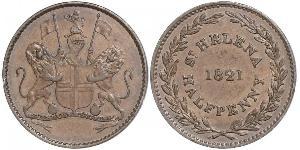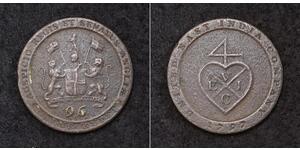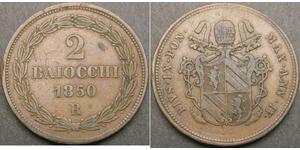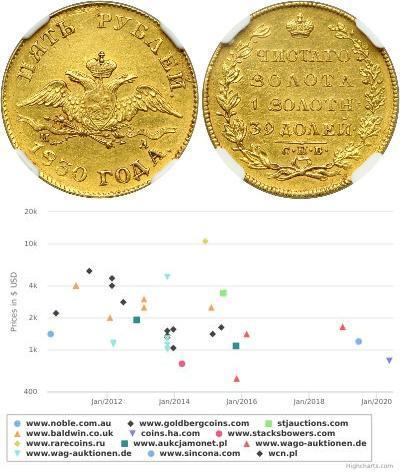1/96 Rupee (Venduta per $46.0)
1797, British India, Madras Presidency. Copper 1/96 Rupee (½ Dub) Coin. VF
Region: India Condition: VF Mint Year: 1797 Reference: KM-397. Denomination: 1/96 Rupee (½ Dub) Material: Copper Diameter: 24mm Weight: 6.41gm
Obverse: Bale mark of the United East India Company (VOC) inside heart-shaped border.
Reverse: Coat-of-arms above fractional rupee value (96 to one rupee) inside field. Legend: TO ONE RUPEE / AUSPICIO REGIS ET SENATUS ANGLIAE
The Dutch East India Company (Vereenigde Oost-Indische Compagnie or VOC in Dutch, literally "United East Indian Company") was a trading company, which was established in 1602, when the States-General of the Netherlands granted it a 21-year monopoly to carry out colonial activities in Asia. It was the first multinational corporation in the world and the first company to issue stock. It was also arguably the world's first megacorporation, possessing quasi-governmental powers, including the ability to wage war, negotiate treaties, coin money, and establish colonies.
The Dutch East India Company remained an important trading concern for almost two centuries, paying an 18% annual dividend for almost 200 years. In its declining years in the late 18th century it was referred to as Vergaan Onder Corruptie which translates as 'Perished By Corruption'. The VOC became bankrupt and was formally dissolved in 1800, its possessions and the debt being taken over by the government of the Dutch Batavian Republic. The VOC's territories became the Dutch East Indies and were expanded over the course of the 19th century to include the whole of the Indonesian archipelago, and in the 20th century would form Indonesia.
The Madras Presidency, officially the Presidency of Fort St. George and also known as Madras Province, was an administrative subdivision of British India. At its greatest extent, the presidency included much of southern India, including the present-day Indian State of Tamil Nadu, the Malabar region of North Kerala, Lakshadweep Islands, the Coastal Andhra and Rayalaseema regions of Andhra Pradesh, Ganjam, Malkangiri, Koraput, Rayagada, Nabarangapur and Gajapati districts of southern Orissa and the Bellary, Dakshina Kannada, and Udupi districts of Karnataka. The presidency had its winter capital at Madras and summer capital at Ootacamund.
In 1639, the English East India Company purchased the village of Madraspatnam and one year later it established the Agency of Fort St George, precursor of the Madras Presidency, although there had been Company factories at Machilipatnam and Armagon since the very early 17th century. The agency was upgraded to a Presidency in 1652 before once more reverting to its previous status in 1655. In 1684, it was re-elevated to a Presidency and Elihu Yale was appointed as President. In 1785, under the provisions of Pitt's India Act, Madras became one of three provinces established by the East India Company. Thereafter, the head of the area was styled "Governor" rather than "President" and became subordinate to the Governor-General in Calcutta, a title that would persist until 1947. Judicial, legislative and executive powers rested with the Governor who was assisted by a Council whose constitution was modified by reforms enacted in 1861, 1909, 1919 and 1935. Regular elections were conducted in Madras up to the outbreak of the Second World War in 1939. By 1908, the province comprised twenty-two districts, each under a District Collector, and it was further sub-divided into taluks and firqas with villages making up the smallest unit of administration.
Following the Montague-Chelmsford reforms of 1919, Madras was the first province of British India to implement a system of dyarchy, and thereafter its Governor ruled alongside a Prime Minister. In the early decades of the 20th century, many significant contributors to the Indian independence movement came from Madras. With the advent of Indian independence on August 15, 1947, the Presidency was dissolved. Madras was later admitted as a state of the Indian Union at the inauguration of the Republic of India on January 26, 1950, and was reorganized in 1956.
Only 1$ shipping for each additional item purchesed!

|
Postato da:
anonymous 2017-09-01 |
|
||
|
||
|
||
|
||
2 Baiocco Stato Pontificio (752-1870) Rame Papa Pio IX (1792 ...
il gruppo ha 3 monete / 2 prezzi
⇑

-600-300-eCUKDaGgCOsAAAFe3ugMJzwP.jpg)

-300-150-OygsHgTytdAAAAGRj3t_gJnj.jpg)
 Deutsch
Deutsch Русский
Русский Українська
Українська English
English Italiano
Italiano Français
Français Español
Español 汉语
汉语





-300-150-fg4KbzbiZkUAAAFGID4OlY0e.jpg)







